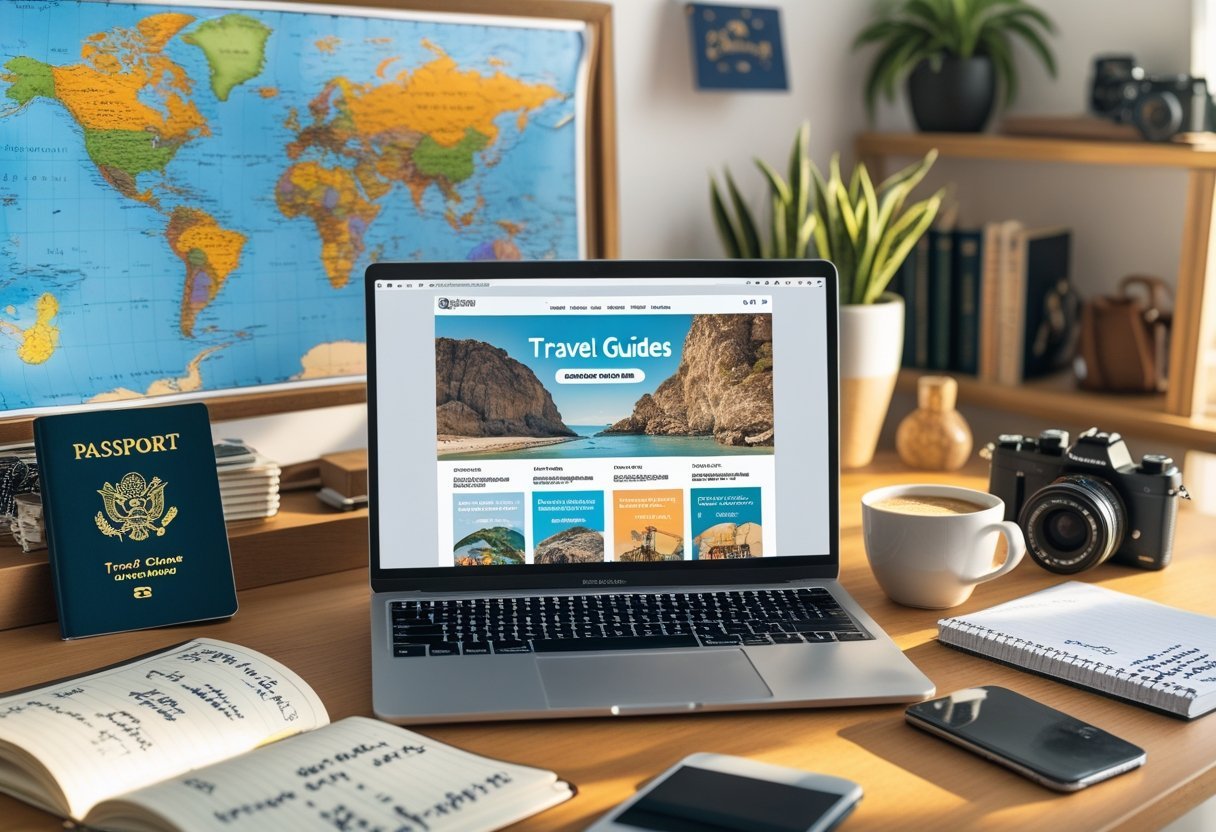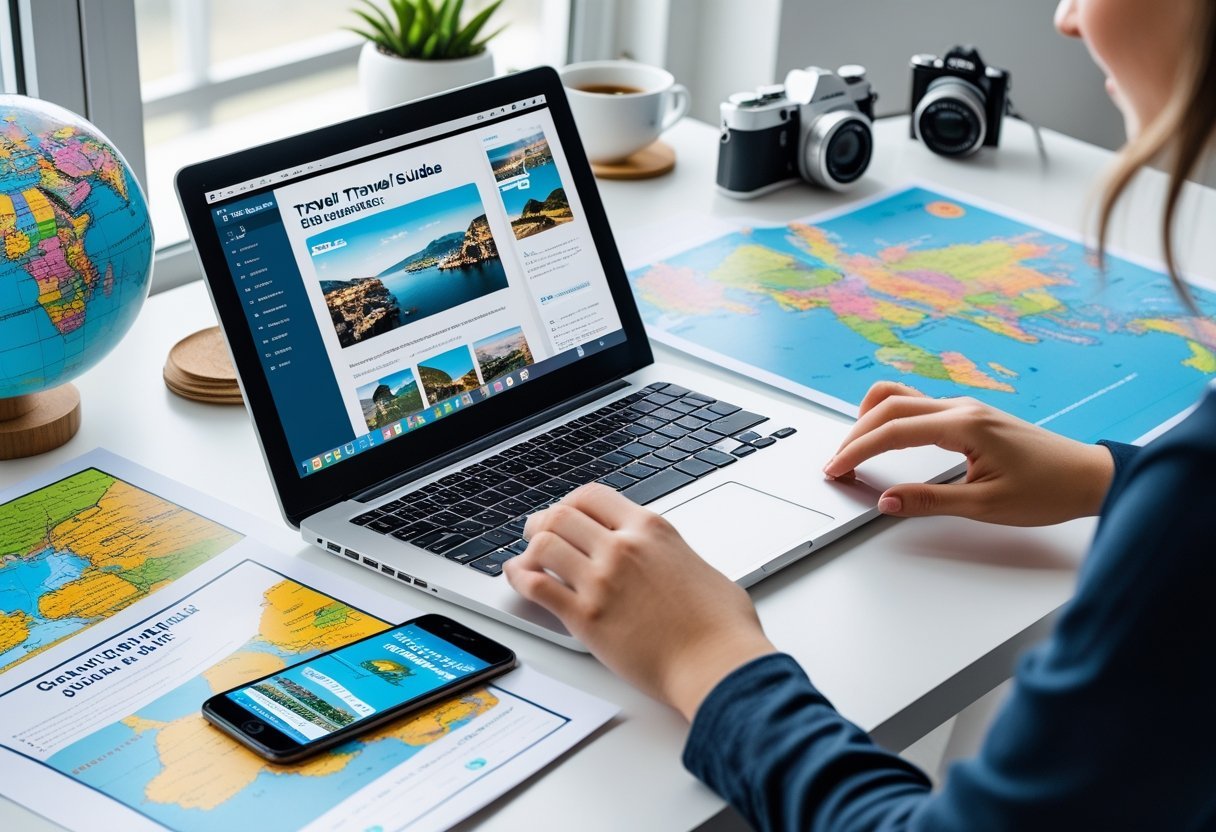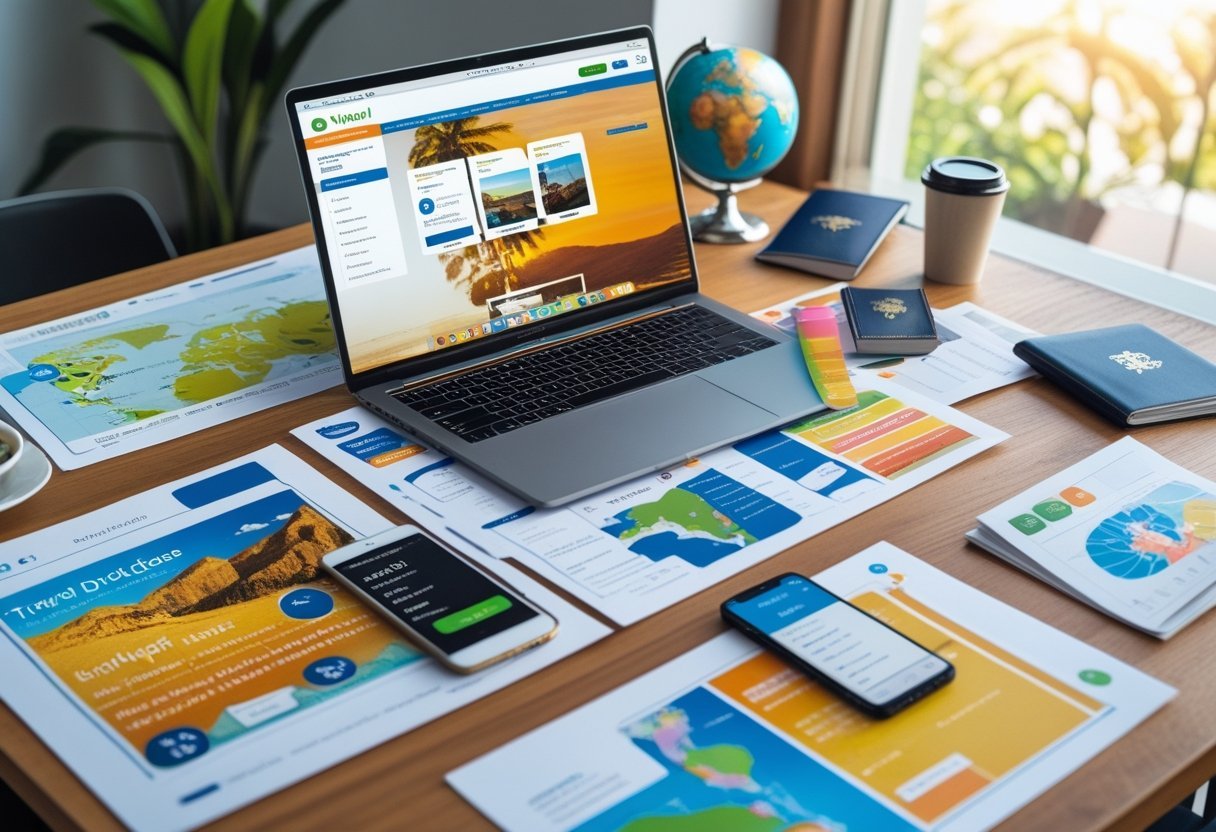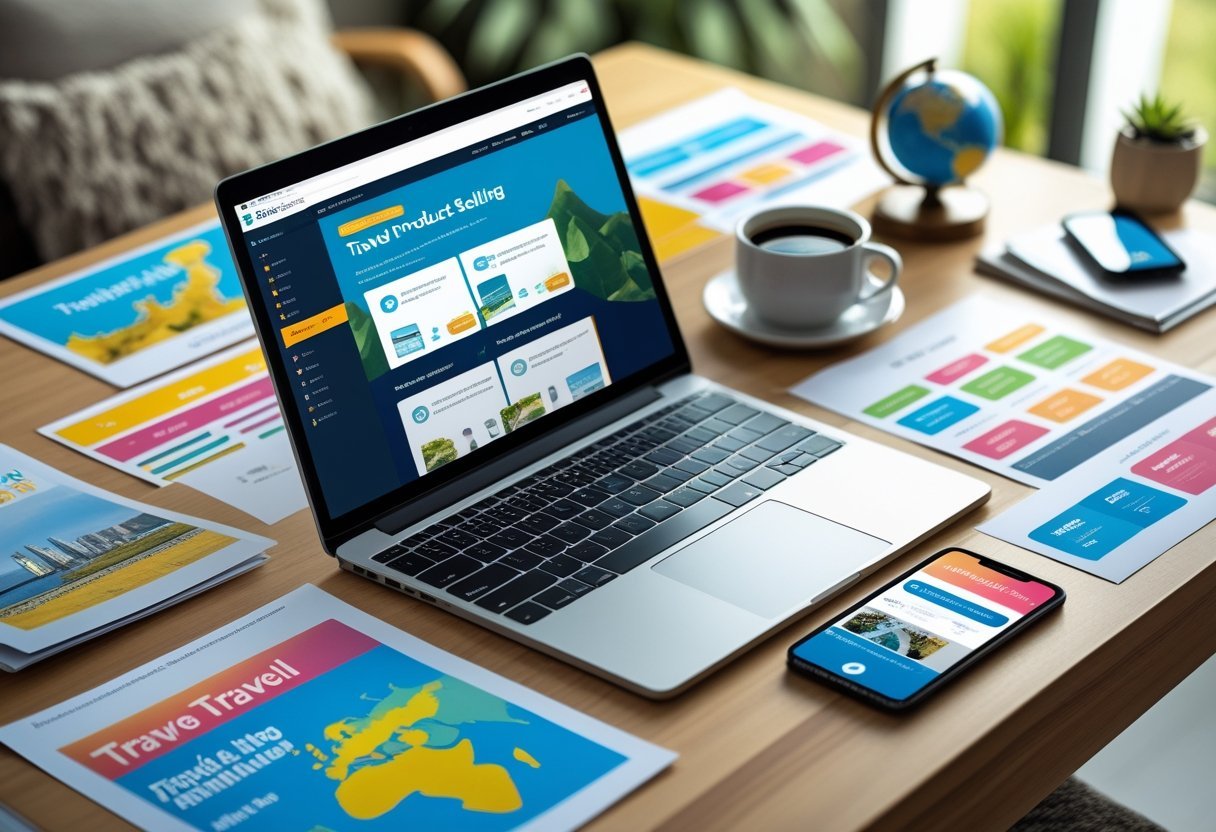You can actually make a steady income while traveling by selling digital products—think printables, travel guides, Canva templates, or Notion planners. These things don’t need a ton of upfront cash, and you can sell them again and again without worrying about inventory or shipping headaches.

Travelers often earn $500 or more per month by creating and selling these easy-to-make digital tools. It’s a way to share your travel know-how (or design chops) and make money from pretty much anywhere.
If you focus on what travelers and remote workers actually need, an online business like this can be surprisingly simple. Your digital products help other people save time and stress, and you get a nice ongoing income stream.
Top Digital Products Travelers Sell Online

There are a bunch of digital products you can make to help travelers plan their trips. Some of the most popular are printables, detailed guides, design templates, and planners for organizing travel details.
Travel Printables and Planners
Travel printables are simple files—packing lists, budget sheets, itinerary planners, checklists. You can whip these up with Canva or Google Docs.
People like printables because they’re instant downloads. You make them once, sell them as many times as you want, and your buyers get to skip a bunch of planning stress.
Themed printables for specific trips (like beach getaways or city breaks) do well. If your designs are clear and the info is genuinely useful, you’re in a good spot.
Custom Travel Guides
Custom travel guides are documents packed with insider knowledge about a place. You can include food spots, places to stay, sightseeing, and your own tips. Some guides are for backpackers, others for luxury travelers—it’s up to you.
It helps if you’ve been there yourself, but solid research works too. Sell them as PDFs or ebooks. Travelers are happy to pay for fresh, honest advice that helps them avoid tourist traps.
Guides for off-the-beaten-path destinations can attract a niche crowd. Make sure your guides are easy to use on phones or tablets.
Canva Templates for Travelers
Canva templates let travelers customize designs even if they’re not designers. You could make templates for trip planning, social posts, photo albums, or journals. These save people a ton of time.
As a creator, you can quickly turn out new templates by tweaking your base designs. Canva’s drag-and-drop setup makes it easy for buyers to change colors, fonts, and text.
Popular templates: travel budget planners, Instagram story packs, vacation photo collages. If your instructions are clear and your designs look good, you’ll probably see more sales.
Notion Planners for Travel Organization
Notion planners are digital tools to keep trips organized—think calendars, to-do lists, notes, budgets, all in one spot. You can sell ready-to-use Notion templates just for travel.
These are great for people who want everything digital and synced. You build out databases and pages that users can adjust as they like.
Stuff like trip countdowns, packing checklists, or itinerary builders works well. If your planner is easy to use and looks nice, it’ll stand out.
Getting Started: Setting Up Your Digital Product Business

If you’re ready to start selling digital products as a traveler, the basics are: pick the right niche, make quality stuff, and use tools that keep things simple. That’s really the core of building a decent online income.
Choosing a Profitable Niche
Choose a niche that fits your travel style and what you actually care about. Printable planners, destination guides, packing checklists—these are all solid options. Just avoid overcrowded spaces if you can.
Google Trends and Etsy search are useful to see what people want. You’ll do better if you can offer something a little different, like guides for digital nomads or Canva templates for travel bloggers.
It helps to target an audience you know (maybe fellow digital nomads or family travelers). That way, you’re making products that actually sell.
Designing and Creating Quality Digital Products
Your products need to be clear and genuinely helpful. Stick to simple layouts and easy-to-read fonts. For printables, use formats that print well—PDF is usually the safest bet.
Travel guides should have detailed itineraries, maps, and real tips from your own trips. Canva templates need to be customizable with simple drag-and-drop features.
Test your stuff before you sell it. Quality matters—a lot. Happy buyers come back for more.
Essential Tools and Resources for Beginners
Start out with user-friendly design tools like Canva, Adobe Spark, or Notion. These come with templates and tutorials, so you’re not starting from scratch.
Use Google Drive or Dropbox for storing and sharing your files. For selling, Etsy, Gumroad, or Shopify are all good bets—they handle the delivery for you.
Track your sales with PayPal or Stripe. And yeah, learning a bit of marketing (Instagram, Pinterest) will help get your stuff in front of more people.
Selling Strategies to Earn $500+ Per Month

Pricing, platform choice, and marketing are what really move the needle. If you get those right, you’re way more likely to hit that $500/month mark (or more, honestly).
Pricing Digital Products for Profit
Check what similar products cost in your niche before setting your price. Printables usually land between $5 and $15. More in-depth stuff (like travel guides or Notion planners) can go for $15 to $40, depending on what’s inside.
Factor in your time and platform fees. Don’t go too low—cheap prices can actually turn buyers off.
Try bundles or first-time buyer discounts if you want to boost sales. And don’t be afraid to adjust prices as you see what works.
Selecting the Best Sales Platforms
Pick platforms with low fees and plenty of buyers. Etsy is a favorite for printables and templates. Gumroad and Shopify are better if you want more control (and they’re solid for Notion planners or guides).
Double-check the fees—Etsy has listing and transaction fees, Gumroad takes a cut per sale.
Make sure whatever platform you use can deliver digital files automatically. Saves you a lot of hassle, and customers expect it.
Marketing Your Digital Products Effectively
Instagram and Pinterest are your friends for showing off your products. Use good images and show how your stuff helps travelers stay on top of things.
Start an email list for special offers and updates. Team up with travel bloggers or influencers if you can—it’s a shortcut to a bigger audience.
Consider simple ads targeting travelers who want to get organized. Keep an eye on what brings in sales and lean into what works.
Optimizing Your Workflow While Traveling

If you want to keep making money from digital products on the go, you need a plan for your time, some automation, and a way to keep your files safe. Otherwise, it’s easy to get overwhelmed.
Managing Time and Productivity on the Road
Try setting a daily schedule that fits your travel plans but leaves room for focused work. Tools like Google Calendar or Todoist can help you keep track of tasks.
Zero in on high-impact tasks—like updating products or doing marketing—when you’ve got the most energy. Find a quiet corner, even if it’s just in a café, and block out distractions.
Pomodoro Technique (25 minutes work, 5 minutes break) helps keep you fresh. It’s simple, but it works.
Automating Your Sales and Customer Service
Use platforms like Etsy, Gumroad, or Shopify to automate sales, payments, and digital delivery. That way, you don’t have to babysit every order.
Set up email autoresponders to handle common questions. Tools like Mailchimp or ConvertKit make this pretty easy.
Schedule your social posts with Buffer or Later so you don’t have to think about marketing every day.
Using Cloud Storage and Collaboration Tools
Keep your files in Google Drive, Dropbox, or OneDrive so you can get to them from anywhere. Seriously, don’t risk losing your work.
Shared folders make it easy to work with collaborators or freelancers if you need help. Feedback is easier that way too.
Always back up your most important stuff. Maybe even use two different cloud services if you’re paranoid (and honestly, it’s not a bad idea).
Scaling Beyond $500: Building a Sustainable Income Stream

If you want to grow past that $500/month mark, it’s all about variety, listening to your customers, and building a base of repeat buyers. That’s how you move toward something more stable.
Expanding Your Product Line
Adding new products keeps things interesting and brings in new buyers. If you’re selling travel guides, maybe add printable packing lists or itinerary templates next. Canva users? Try out different styles or themes for different places.
Stick to products your current customers will actually want. Bundles and seasonal items (like summer planners) can bump up your average sale. Don’t be afraid to experiment and see what takes off.
Leveraging Customer Feedback for Growth
Customers will tell you what’s working and what’s not—if you’re paying attention. Watch reviews and DMs for ideas or requests. Social media polls or quick surveys can be surprisingly helpful.
If people keep asking for guides to lesser-known places, make those. Respond fast and show you care—it goes a long way toward getting repeat buyers.
Building a Loyal Audience as a Traveler
Stay in touch with your audience, whether that’s through emails or whatever social platform you like best. Drop travel tips, share little updates, or tease new products every now and then.
People love feeling included, so let them in on your adventures. Use your own stories and photos—it just feels more real that way.
If you’ve got discounts or early access to offer, don’t be shy. It’s a nice way to say thanks, and honestly, it might even turn a casual fan into someone who keeps coming back.




